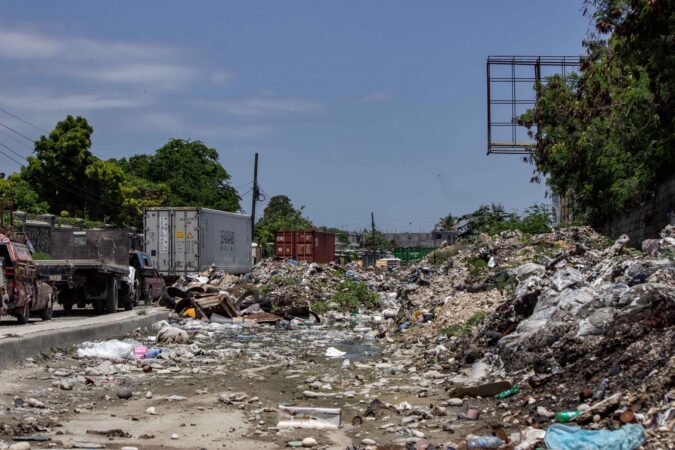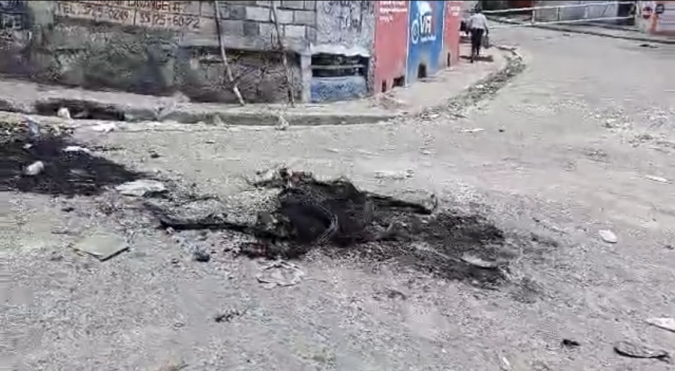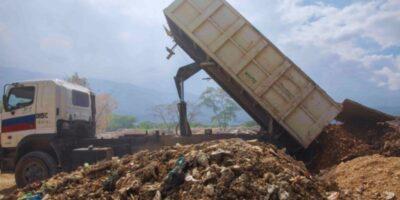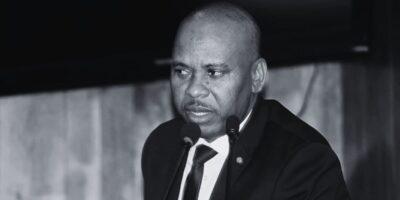Day and night, death visits several « kafou » in Port-au-Prince
[Warning: This article contains potentially shocking images].
Passersby, bandits and victims of « bwa kale » regularly meet with death in most of the intersections of Port-au-Prince.
It was 1:28 p.m. on Tuesday, May 7 when, on the filthy sidewalk of Avenue Christophe in Port-au-Prince, the corpse of a man was ablaze.

A burning corpse in the middle of the day near the Sacré-Coeur school. | © Jean Feguens Regala/AyiboPost
Near the motionless body, close to Lafleur Ducheine, a pile of garbage spread a foul smell, adding to the atmosphere already weighed down by the wisps of smoke rising above the scene.
The same scene can be observed along several other arteries in the area, including Rue 4, now nicknamed « cemetery » or « kafou lanmò. » In the entire metropolitan area, there are at least a dozen, if not more, of these intersections.

Smoke rising from a burning corpse on Avenue Christophe.
« Not a day goes by without someone killing a person or throwing a corpse [there], » says a young man from Avenue Christophe in an attempt to explain the origin of the name.
Dressed entirely in black, the young man in his twenties is the only one among passersby who agreed to speak briefly to AyiboPost, while remaining particularly suspicious. He prefers to remain silent about who is responsible for these acts or the accusations made against the victims.
Day and night, death visites several other « kafou » in Port-au-Prince.

Persistent smoke at Maïs Gaté caused by the burning of human corpses.

A resident of Maïs Gaté shows skeletons on a pile of garbage.
At the entrance of Delmas 19 a few dozen meters from the airport road.
At La Rue J. Baptiste in Delmas 33.
Or on Avenue Maïs Gaté and Rue Jaques Roumain where the prestigious building of the Ministry of Public Health and Population stands.

A restaurant in Maïs Gaté cannot function due to the many executions and dumpings of corpses in its vicinity.
In this area, for example, a car washer recounts how he and his companions have offered their services to vehicles stopping in front of their small roadside washing business. »Instead, we see hooded and heavily armed men descend, forcing us to flee. »
Some attackers simply shoot their targets before leaving, continues the car washer. Others, he says, choose to burn the bodies.
Finally, he mentions those who take sadistic pleasure in burning their victims alive, thus leaving them no chance.
Dany Junior, one of the car washers on Avenue Maïs Gaté, is disturbed because his business is declining. « Since customers know that people are regularly killed here, they hardly come to have their cars washed, » he explains.
When burned, the bodies of the victims effectively become unrecognizable.

Charred human skeletons have been discovered on a pile of garbage in Maïs Gaté.
As a result, it becomes almost impossible for members of the population to check whether the remains of their missing loved ones are among the garbage heaps, in a context where no public institution systematically counts the dead. No one will know exactly how many Haitians have died in recent years.
The unclaimed bodies end up being devoured by dogs.
When asked about this, Exalus Jeanty Fils, director of the MSPP’s Coordination and Public Relations Unit (UCRP), preferred to answer as a doctor rather than as an executive of the ministry.
He acknowledges that these corpses, left almost at the doors of the ministry on Avenue Maïs Gaté, are a public health problem because they can lead to the spread of diseases.

A pile of rubbish not far from the MSPP. May 7, 2024
The MSPP, according to the doctor, manages waste and corpses at the hospital level to avoid contamination and the spread of diseases. As soon as they are found on public roads, the MSPP draws the attention of each sector concerned to the need to respond, continues Fils. « But it is the responsibility of the Ministry of the Interior and the Ministry of Social Affairs to take care of this via the town halls concerned, » he concludes.
The Tag Market intersection, at the corner of Rue Faustin and Rue Bois Patate, is also regularly associated with death.
According to several residents of Turgeau and Canapé Vert interviewed by AyiboPost, members of vigilance brigades, and sometimes police officers, go to the area to execute individuals suspected of banditry.
In addition, an unofficial court was established at Rue Renne. Gang members are interrogated before eventually being executed at the nearby Tag Market’s « kafou lanmò. »
« As soon as I hear gunshots in the middle of the night, I know someone has been executed, » a young resident of the area told AyiboPost. She works in administration and asks to remain anonymous for security reasons.
She adds that this sometimes happens « three or four times a week. » « Smoke and smells are invading homes, » she says. « The dogs feed on the remains of unburned corpses. It’s disturbing. This keeps you awake at night. »
The shock of these executions causes stress and anxiety. « The problem with this reality is that it dehumanizes us, it takes away our sensitivity, » warns Gihane Dejoie Mathurin, a psychologist and member of the American Psychological Association.
The mutilated dead are seen from time to time on Rue Rivière, near the rector’s office of the State University of Haiti.

Charred bodies near the rectorate of the State University of Haiti.
On March 8, 2024, a burning corpse could be seen in the area. A woodworker who lives on the street told AyiboPost that the previous evening he saw two men take another to the side of the rectorate before executing him.
« They came back a few hours later to set fire to the corpse, » he says. Two other people in the area confirm this version of events.
For clinical psychologist Jacqueline Baussan, it is a sign that « death, as brutal and violent as it is by nature, no longer seems to cause fear, anguish or compassion: it is trivialized. »
And this requires above all the trivialization of the violence to which we are constantly exposed, whether on social networks or in our daily lives. As a result of the constant kidnappings, rapes and torture, « they ended up robbing us of our humanity, » Baussan believes.
And those who have directly suffered this violence, those who are exposed to the images of this violence « end up being deeply traumatized. »
Corpses and violent images can cause or accelerate different kinds of diseases.
This usually manifests itself in hypertension, strong palpitations, back pain, sexual difficulties and so many others, warns psychologist Gihane Dejoie Mathurin.
Improper handling of dead bodies can also pose a health risk.
According to general practitioner Yourry Ginel Richard, « when we set fire to corpses, we are sure to contaminate the soil, the water tables, depending on the area, and then those who have access to this water. »
Improper handling can also facilitate the spread of certain diseases such as HIV.
By Rebecca Bruny et Widlore Mérancourt
The photos are by Jean Feguens Regala.
Cover image edited by AyiboPost in which a resident of Maïs Gaté shows bones of corpses on a pile of rubbish. | © Jean Feguens Regala/AyiboPost
Keep in touch with AyiboPost via:
► Our channel Telegram : Click here
► Our Channel WhatsApp : Click here
► Our Community WhatsApp : Click here







Comments